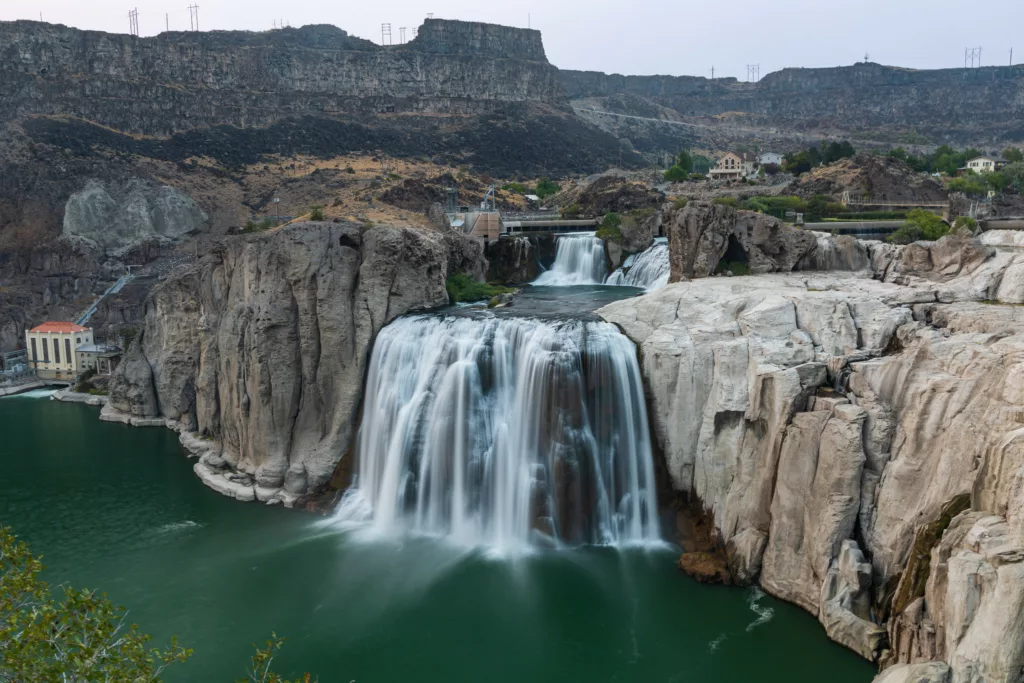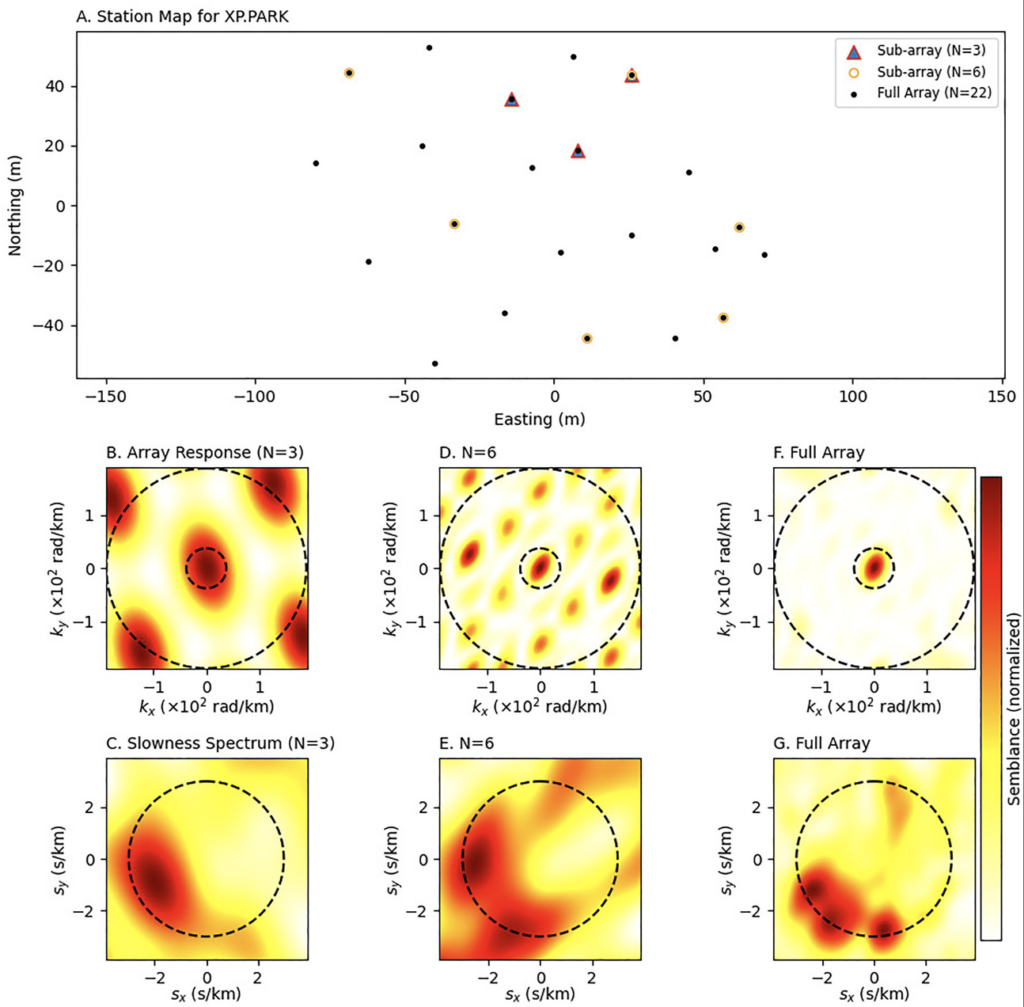
Even though we can’t hear low-frequency signals, infrasound sensors—essentially microphones—can pick up all sorts of earthly sounds. Low-frequency sounds travel longer distances than humanly audible ones, retaining more energy. This feature makes infrasound especially useful for remotely monitoring our environment.
In a new study published in Geophysical Research Letters, scientists from Boise State University used a dense array of 22 microphones spread over a 100 by 150 meter area to listen for sounds, both near and far. For 58 days of data collection, they observed a variety of interesting sources ranging from distant waterfalls to thunderstorms hundreds of kilometers away.
Arrays of infrasound sensors
Scientists use infrasound sensors to monitor a variety of sound sources, like nuclear explosions or volcanic eruptions. Traditional arrays of three or more sensors can pinpoint the direction of the acoustic source. “Infrasound arrays with at least three sensors can estimate the back-azimuth, or direction a wave is coming from. Using the difference in the wave’s arrival time at each sensor, the array geometry and some trigonometry, we can estimate this direction,” says Logan Scamfer, previously an undergraduate at Boise State and now a graduate student at University of Alaska Fairbanks. “Arrays require at least three sensors because with only two, waves arriving from multiple directions could have the same arrival time difference, creating an ambiguous solution.”
Large-N arrays involve many more than three sensors to estimate the source of an acoustic signal. By listening closely, weaker signals that would otherwise be obscured by a louder source may become detectable. More sensors also mean better resolution of where the source is relative to the sensors, as well as better resolved velocity (technically slowness, which is the inverse of velocity)—useful for determining paths that waves travel through the atmosphere.
There are also a few tradeoffs. “Adding more sensors to an array means having to buy more instruments, spending more time in the field setting them up and replacing used-up batteries and memory cards, and dealing with more computational challenges managing and processing data,” says Jake Anderson, a geophysicist at Boise State and Scamfer’s undergraduate advisor. “But, if we put forth that effort, we can get scientific results that would otherwise be impossible.”
To that end, the team used the PARK station, a large-N array of 22 infrasound sensors located in central Idaho, to see what they could see (or hear what they could hear). The PARK station was established after the 2020 magnitude 6.5 Stanley, Idaho earthquake in an effort to listen for aftershocks. For about two months—from 15 April 2020 to 11 June 2022—these infrasound sensors, having been installed in a wooded area to reduce wind noise, also listened to background sounds of Idaho’s mountains. (The infrasound data are available from the NSF SAGE data archive operated by EarthScope.)
Chasing waterfalls, small and large
Waterfalls and whitewater—rapid, turbulent, foamy streamflow—are known to be significant sources of infrasound. Scamfer and Anderson identified two waterfalls that made enough noise for the PARK array to hear. The first, Lady Face Falls, is only 7.88 kilometers from PARK, and sits within a perennial mountain stream that relies on melting snowpack. The infrasound signal attributed to Lady Face Falls appeared quiet and continuous, and sometimes undetectable if winds were whipping. The signal first appeared on the last day of April 2020, and eventually became the dominant source of sound at PARK.
“The signal we detected from Lady Face Falls is similar in power (loudness) and frequency (pitch) to other waterfalls of about that size that I’ve studied,” Anderson says. “It also shows a common pattern where as its flow increases, its infrasound becomes both louder and deeper.”
The sudden appearance of the Lady Face Falls signal, Scamfer says, “we attributed to greater infrasound amplitudes associated with increased discharge on Stanley Lake Creek.” The increased discharge likely sourced from warm temperatures initiating snowmelt.
The team also identified similarly quiet and continuous signals from about 195 kilometers away, and from a different direction than Lady Face Falls. These signals likely source from the Twin Falls and the Shoshone Falls, which reside on the Snake River and are among the largest in the region. The falls, however, are not detected at PARK when water discharge drops below a certain threshold. In other words, enough water needs to be pouring down in order for the infrasound signal to be loud enough to hear at PARK, nearly 200 kilometers away. And, Scamfer points out, favorable atmospheric conditions are also necessary.
In fact, when the atmosphere is just right, acoustic signals can travel incredibly far via something called atmospheric ducting. “Atmospheric ducting is when infrasound waves are refracted [or bent] up into the atmosphere, and eventually refracted back down to the surface,” Scamfer explains. This bouncing of waves means the signal can travel great distances, but only under the right conditions. “These refractions are dependent on the effective sound speed at different altitudes in the atmosphere, which are affected by atmospheric temperature and wind profiles,” he says.
Lightning and thunder
Thunderstorms also generate infrasound, and such storms are easily identified using the World Wide Lightning Location Network (WWLLN), which uses low frequency radio sensors to locate lightning strokes around the world. Scamfer and Anderson were able to compare stormy infrasound signals with numerous strokes in the WWLLN data.
Specifically, the infrasound sensors detected current pulses. In a cloud-to-ground flash, which is the best studied form of lightning, current pulses are return strokes, says Anderson, but other types of lightning have current pulses, too. “The high current in these events heats the air and makes shock waves, which decay to low-frequency audible and infrasound waves and can travel long distances.” These rumbles were the signals PARK picked up.
Although the team identified more nearby storms than distant ones, some proximal storms went undetected at PARK. This may result from PARK station being in a storm’s shadow zone—a region where neither direct arrivals of infrasound nor atmospheric refractions can reach, Scamfer says.
One storm detected by infrasound was between 800 and 900 kilometers away from PARK, and occurred on 19 May 2020. This storm, classified as “severe” by NOAA, included hail and strong winds. Though detection of storms at such great distance is rare, it’s not unheard of, with some storms observed via infrasound at distances greater than 1,000 kilometers.
Noisy earthquakes
Earthquakes can produce infrasound signals in a variety of ways, but primary earthquake infrasound is key for detecting local, nearby events. Primary earthquake infrasound (sometimes called local infrasound) is the conversion of seismic waves that travel through the ground to infrasonic waves at the sensing array. The infrasound signal arrives at nearly the same time across the array because the seismic waves travel at a much faster speed than infrasound.
Because the PARK array was set up to monitor aftershocks of the magnitude 6.5 Stanley, Idaho earthquake, the team saw many earthquake detections near the beginning of the study period, as would be expected because aftershock occurrence decays after the mainshock. At day 17, earthquake detections became intermittent.
Interestingly, Scamfer and Anderson also identified secondary infrasound signals (with a detailed discussion of interesting secondary infrasound-related findings here). “Secondary infrasound is produced when seismic surface waves interact with areas of high relief (like mountains) or sedimentary basins, producing infrasound waves,” Scamfer explains. “This secondary infrasound then propagates to the array, where it can be detected.” This signal sporadically overpowers the infrasonic drone of Lady Face Falls.
More is better
Had only a three-element array been in place, Scamfer and Anderson noted that many, if not all, of the detected signals could have been lost to background noise. By combining a large-N array with standard methods for identifying where a signal came from, they identified waterfalls, storms and aftershocks of the 2020 Stanley, Idaho earthquake.
Therefore, this strategy could be useful beyond geophysical studies. For instance, scientists could monitor waterfalls from farther away than typical hydrological and geomorphic methods allow.
And such sensors could even explore worlds that aren’t our own. “The large-N array method has potential applications in aerial seismology, which uses infrasound sensors on airborne balloons to obtain information about seismic ground motion that has coupled into the atmosphere,” Scamfer says. “Planetary bodies that have too harsh of surface conditions for seismometers (like Venus), could use balloon-based sensors for seismic studies.”






